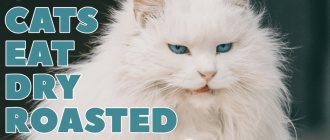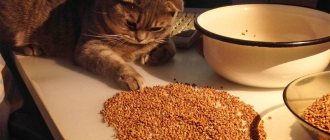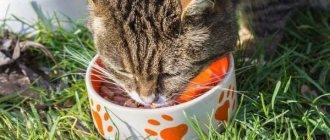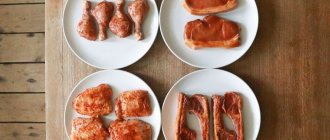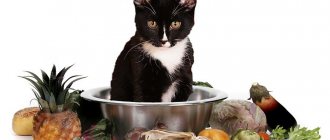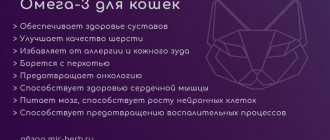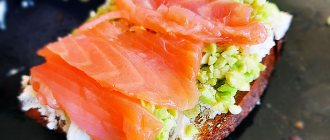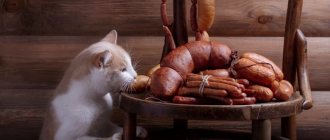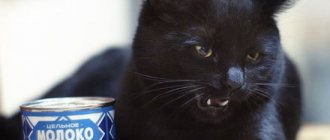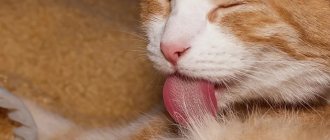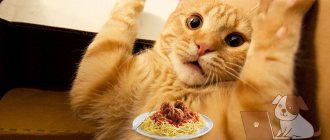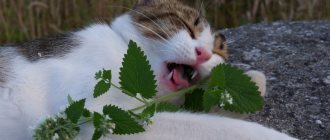Once upon a time, a man tamed a cat so that it would protect barns from rodents, because it eats mice and rats, but does not eat grain. But millennia passed and feeding cats porridge suddenly became a tradition. However, before you pour cereal into water to make porridge for your pet, read this article. It turns out that not everything is so simple.
The article is part of the Natural Cat Nutrition section. The article continues after the advertisement.
Feeding cats porridge: three opinions
On the question of what kind of porridge to cook for cats, kittens and cats, and whether this can be done at all, there are three different points of view.
Opinion No. 1. The first point of view about whether cats and kittens can eat porridge says that it is not only possible, but also necessary. This opinion, by the way, is shared by many veterinarians. They explain their point of view by the fact that the stomachs of the victims of cats - mice and birds - contain cereals. Therefore, porridge is a must in the diet as a source of fiber, vitamins and microelements. Adherents of this point of view clarify which porridge is best to feed a cat, kittens and cats, and which one is not worth it. But there is no common opinion on this matter between supporters of the theory. Some people allow buckwheat, rice and oatmeal. Someone says that rice is strictly forbidden, but buckwheat, oatmeal and barley are ok. And so on. You can hear many different opinions about this or that type of cereal.
Opinion No. 2. The second point of view says that cereals for cats are more likely to cause harm than benefit, but they are still acceptable if the animal does not have obvious negative reactions to such food. There are also quite a lot of veterinarians among adherents of this point of view. At the same time, they stipulate that cats cannot have porridge every day and its share should be up to 25% of the diet, but better - 5-10%.
Opinion No. 3. The third point of view on whether it is possible to feed a cat, cat or kitten with porridge, the answer is a categorical “no”. In nature, cats do not eat porridge, and the grains that fall into the cat along with the victim’s stomach make up a microscopic amount, moreover, they are already fermented by the rodent’s body. And many cats avoid eating the stomach and intestines, because... These parts are the most tasteless. Therefore, cereals that are healthy for kittens simply do not exist. A cat can get fiber not from grains, but from vegetables. It is needed in an amount of no more than 5-10% of the diet. And in any case, the cat will not even absorb vitamins and microelements from cereals, because... Her body can obtain everything it needs only from products of animal origin, because... The cat is an obligate (“obligatory”) predator.
Why is there three points of view on the simple question of what kind of porridge can be cooked for a cat, cats and kittens? Was it really impossible to come to a common opinion? The reason for this range of opinions lies in several reasons.
Firstly, cats have a pancreatic enzyme called amylase, which can break down grains. Nature gave it to the cat just in case, because, indeed, in addition to the prey, a predator can also get some amount of carbohydrates into the stomach. But the problem is this: just because a cat CAN process microscopic amounts of grains that accidentally enter its stomach does not mean that they are USEFUL. Supporters of the first two points of view forget about this.
Secondly, there is a tradition that comes from the USSR, when, in conditions of shortages and saving money, people fed cats and dogs with porridge. This tradition has been preserved in many families to this day, and many veterinarians simply accommodate people who want to save money. This is usually done by supporters of the second point of view, who understand that porridge is not a very suitable food for cats.
Article continues after advertisement
Thirdly, feed manufacturers played a major role in shaping opinions regarding the benefits of cereals, adding cereals to feed in order to save money. Under this, they brought a whole theoretical basis about the contents of the stomach of a mouse, which is now cited by many veterinarians - supporters of factory nutrition. At every seminar and conference for veterinarians and felinologists, company representatives tell this theory. In addition, as you know, feed manufacturers have contracts with each clinic regarding a percentage of feed sales. Please note that almost all clinics have signs of some kind of food or stands with these products inside.
The author of the article you are reading initially fed the cats cereal on the advice of a veterinarian. However, then, having studied all three points of view, I came to the conclusion that the third opinion on the ban on grains is the most correct. What made me think about this was immersing myself in the intricacies of feline physiology and studying the opinions not of ordinary veterinarians, whose level of knowledge varies, but of the best veterinarians in the world. Agree, there are many specialists, but you need to listen only to the best.
Further in the article we will consistently prove the correctness of the third point of view, and will also tell you which cereals are the most harmful and how you can replace cereals in your diet.
The effect of buckwheat on the cat’s body
Buckwheat, useful for cats, contains a complex of vitamins and minerals necessary for the animal. Their intake into the body of a domestic cat is extremely important, since in an apartment the animal is not able to independently obtain the necessary elements. In this case, the valuable properties of buckwheat for the cat’s body cannot be overestimated. Buckwheat, being the leader in iron content among all cereals, fully satisfies the body's need for this element. This, in turn, ensures the full functioning of the cat’s cardiovascular and circulatory systems. In addition to iron, buckwheat also contains many other beneficial substances :
Thus, taking into account the fact that buckwheat as food contains so many useful microelements, it becomes clear that feeding a cat porridge is extremely useful.
What cereals can be cooked for cats, kittens and cats?
Beginning cat breeders are wondering what cereals can be given to kittens and adult cats and how to teach a cat or kitten to eat porridge? We are all accustomed to the fact that porridge is good for people, because... it gives a lot of energy. As a child, our mother and grandmother told us: we need to eat porridge in order to grow up strong and healthy. We remembered this and now we are trying to use it on cats, because we want only the best for them...
But the cat’s body works differently: cats are predators that can process a certain amount of grains, but such a product is not only not necessary for them, but can also cause harm. Open any textbook on cat physiology: cats only need proteins and fats of animal origin to live - they get all the useful vitamins and minerals from meat and bones. At the same time, their body is adapted to process small amounts of carbohydrates that make up cereals, thanks to the pancreatic enzyme amylase. It is this enzyme that cats owe to the fact that their owners now stuff them with porridge, sometimes even without meat. And it is precisely the fact that cats have amylase that digests cereals that is cited as an argument by veterinarians who are supporters of feeding cats porridge.
But let's figure out why the world's leading veterinarians - specialists in feeding cats - are against this. In particular, we are talking about Doctor of Veterinary Medicine Karen Baker, veterinary nutritionist Lisa Pearson, nutritionist Kimity Schultz and many others. The fact is that quite a lot of research has been conducted showing that grains (cereals) are harmful food for cats. In nature, predators do not eat this, so we will not think about how to force a cat or kitten to eat porridge or how to trick a cat into feeding it porridge, for example, by boiling it in broth. Why, even if a kitten or cat loves and eats porridge, is it better not to offer such food?
It turns out that during the normal physiological process, the enzyme amylase for digesting cereals in cats is just enough to process several grains that got inside along with the stomach of the victim - rodents and birds. But this measure is forced, cats have amylase so that, having consumed the mouse along with the stomach, the cat does not diarrhea and waste the precious meat, caught with such difficulty.
In addition, as we have already said, the cereals in the mouse’s stomach have already begun to undergo fermentation. This is not at all the same porridge that people offer their pets. This is called chyme. In addition, cats often do not want to eat the stomach and intestines of the victim. Thus, a pancreatic cat needs to secrete very little amylase in order to process those single grains that sometimes fall along with the carcass. This is how it works in nature.
But a person feeds a cat grains differently. Firstly, they are not fermented by a rodent's stomach. Secondly, owners offer their pets porridge regularly and obviously not just a few grains at a time. Thirdly, porridge is often also cooked in meat broth, which causes additional damage to the digestive system. That is, conditions are artificially created under which the cat regularly consumes a significant amount of grains. This raises a number of serious problems.
Reviews
Alexander, veterinarian, Khabarovsk: “I think that buckwheat is one of the most useful for feeding domestic cats. This cereal contains enough vitamins and microelements to reliably provide a small pet with the substances necessary for normal life.
However, it is important to add animal protein to the cereal, without which complete nutrition for cats is impossible.”
Albina, specialist at a veterinary clinic, Chelyabinsk: “Buckwheat must be present in the diet of cats. It does not cause allergies and is quickly absorbed.
Cereals contain a lot of plant fiber, which is necessary for representatives of the cat family. It helps to effectively get rid of fur in the stomach, which they swallow when licking.”
Maxim, 56 years old, Vladivostok: “When we adopted a kitten for our grandchildren, during the examination at the clinic they advised us to give it liquid buckwheat porridge as complementary food.
At first I didn’t want to eat, even when they cooked the cereal in milk. But when he grew up, they began to cook buckwheat in meat broth and mix it with minced meat. Gradually our cat began to taste the treat. Now he never refuses this dish.”
Cat owners need to learn how to properly prepare buckwheat porridge and enrich it with animal proteins (meat or fish). However, before introducing such complementary foods into your cat’s diet, it is advisable to consult with a veterinary clinic specialist. Especially if the pet has any serious illness or is too young or old.
Source
Why can't cats have porridge?
As you already understand, the answer to the question of what cereals cats, cats and kittens can eat is “none.” In any case, we propose this point of view as the main one. In nature, a cat does not eat porridge. You can force it to do this by mixing cereals with meat - the main product in the predator’s diet. But this can cause harm. Let's list specific reasons why your cat should not be offered porridge.
Article continues after advertisement
Why are grains dangerous for cats?
- Grains are not a natural food for cats. During the time that the cat began to live with humans, it did not have time to evolutionarily change the type of digestion. Cats, like true predators, have a very short intestine, and carbohydrates are digested there. Herbivores have very long intestines for these purposes. The cat's short intestine does not have time to cope with grains. Therefore, at best, they pass through the gastrointestinal tract in transit without being absorbed. At worst, they cause harm.
- Phytic acid, contained in all cereals, leaches existing mineral reserves from the body, which is dangerous to health.
- Gluten, contained in some cereals, is a dangerous substance that leads to allergic reactions, inflammation, decreased immunity and other negative consequences, including mental disorders. You can read more about gluten in grains and their effect on dogs and cats in an English-language article by veterinarian Karen Baker.
- All grains are potent allergens for cats.
- Grains can in some cases damage the mucous membranes of the gastrointestinal tract of cats.
- Cereals are often contaminated with mycotoxins and other poisons. Eating contaminated grains sometimes causes serious consequences, including the death of the animal.
- The consumption of cereals contributes to the disruption of the barrier functions of the mucous membrane of the cat's bladder, as a result of which an ascending infectious process can begin and struvite stones appear.
Now let’s take a closer look at some of the nuances that are worth focusing on.
Digestive disorder
The most harmless thing that can happen is that the porridge will give your cat diarrhea. This occurs when the pancreas secretes very little amylase - as a result, consuming grains that cannot be digested in any way causes indigestion. This may also cause blood in the stool and gas.
However, many cats do not have diarrhea from grains, but only become profuse in their stool, in which, if desired, you can sometimes even see undigested grains. Most owners do not pay attention to this, and therefore continue to feed their pets with cereal. As a result, much more serious consequences may develop. It would be better if there was diarrhea, which would force the owner to completely stop feeding grains.
Rarely does porridge cause constipation. In this case, the cereal masses stand like a stake in the intestines, peristalsis slows down. This whole mass begins to rot, causing illness. But the cat’s owner, of course, would not think that porridge could cause constipation, because for people it’s the other way around: cereals relieve constipation.
EXPERT COMMENT
